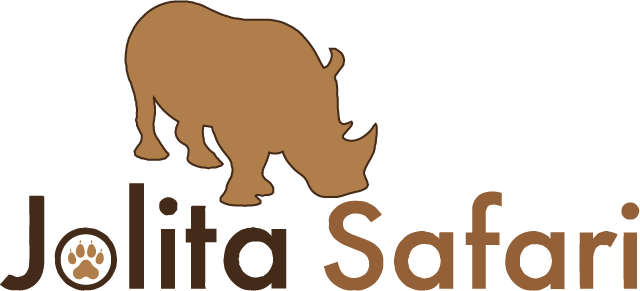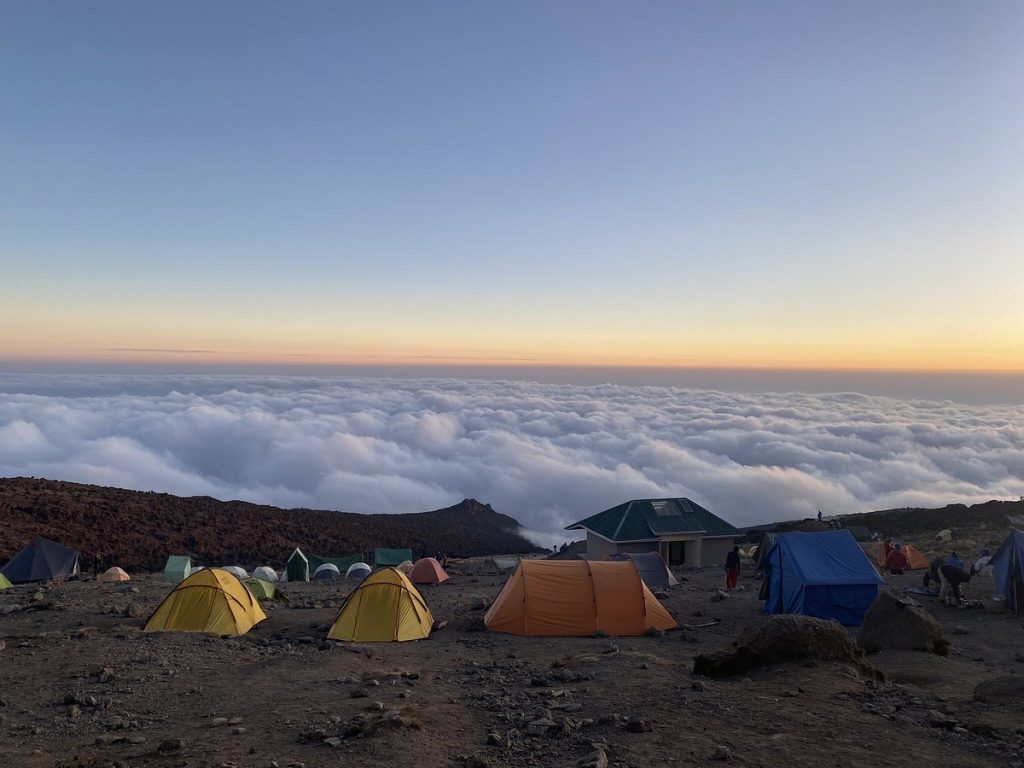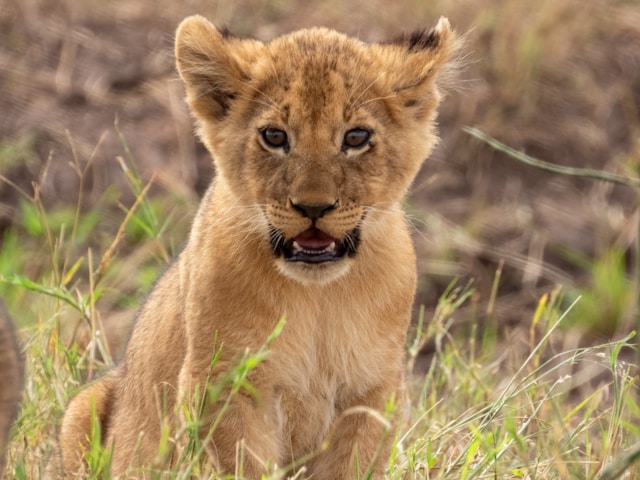Rwanda is among the smallest countries located in the Great Lakes region of East Africa. It is bordered by the Democratic Republic of the Congo, Uganda in the North, Tanzania, and Burundi. The capital city of the country is Kigali and the country is under the rule of President Kagame
Size
Rwanda has a total size of 26,338 square kilometers,
Geography
Geographically, Rwanda is located on the eastern rim of the Albertine Rift, a western arm of the Great Rift Valley, on the watershed between Africa’s two largest river systems that is the Mighty River Nile and the Congo River. Much of the country’s land is mountainous and the highest peak is Karisimbi which is at 4,507m high in the volcanic Virunga Mountains which are protected by the Volcanoes National Park. The largest body of water is Lake Kivu, however there are other numerous lakes around the country such as Burera, Ruhondo, Muhazi and Mugesera.
Population
The country has a population of about 14 million in 2023. Much of which is indigenous Community like the Batwa who are hunter-gatherer, Pygmies and have lived in Rwanda and other countries surrounding the Great Lakes Region. Before their eviction in the 1990s, the Batwa people lived in the forested region that currently comprises the national parks of Mgahinga, Bwindi, and Echuya.
Economy
Rwanda is a subsistence agriculture economy, Rwanda nonetheless produces for export some of the finest tea and coffee in the world. Other industries include sugar, fishing and flowers for export.
Money Unit
Rwanda’s unit of currency is the Rwandan franc (RFr). Other preferred unit of currencies is the US dollars, British Pounds, EUROS and the East African shillings including Uganda shillings, Kenya shillings and Tanzania shillings
Getting There
All international flights arrive at Kigali International Airport, just 10 Km from central Kigali. International flights and Airlines operating in Rwanda are SN Brussels, Kenya Airways, Ethiopian Airlines, Air Burundi and Rwandair Express.
Passport and Visas
A valid passport with visa is mandatory/necessary to enter Rwanda. In view of the bilateral agreements, nationals of the following countries may visit Rwanda without visa for a period up to 90 days: USA, UK, Germany, Canada, Uganda, Tanzania, Kenya, Burundi, Democratic Republic of Congo, Sweden, Mauritius, South Africa and Hong Kong. Visas can be applied for online from the Immigration website or bought upon arrival.
What to do in Rwanda
City tours , Cultural tours, Gorilla Tracking Safaris, Golden Monkey tracking, Bird watching ,Boat cruise , Genocide Memorial tours ,Wildlife tours
Where to go in Rwanda/ Paces to Visit in Rwanda
Virunga Mountains for Gorilla Tracking/Trekking in Parc Des Volcans, Genocide Memorials site, Dian Fossey’s Remains-Karisoke Research Center, Akagera National Park, Nyungwe forest National Park, Musanze Cave,Gisenyi city, Virunga Mountains , Kinigi City , Ruhengeli Town,Lake Kivu , Tour Kigali City
When to visit Rwanda
The country can be visited at any time of year. The dry season range from mid-May to mid-October and this season is easier for tracking mountain gorillas. Peak season for gorilla tracking is July and August, traveling outside this time means it is easier to arrange a permit.
Wildlife
Rwanda has a wide variety of wildlife. These include the endangered mountain gorillas, herds of elephant and buffaloes, Giraffes and zebras milling in the savannah, more than a dozen species of antelope which include the chestnut-coated impala, the diminutive oribi, the ungainly tsessebe, the secretive bushbuck, the statuesque Cape eland etc.
Gorilla Tracking
Rwanda is a famous destination for mountain gorilla tracking in Africa. Together with Uganda and Congo, the country protects the remaining few 720 mountain gorillas that thrive in the world. Gorilla Tracking is carried out in five gorilla groups within Parc Nationale des Volcans.
Gorilla Permits
Gorilla Permits can be arranged by a travel operator, or can be purchased directly through the Office Rwandaise du Tourisme et des Parcs Nationaux (ORTPN) / The Rwanda Office of Tourism and National Parks, at the headquarters in Kigali, or at their office in Musanze.
Language
The country’s indigenous language is Kinyarwanda and in additional to this French and English are recognized as official languages. French is widely spoken throughout the country.
Public Holidays
Good Friday and Easter Monday, which fall on variable dates, are recognized in Rwanda. Other public holidays are:
1 January (New Year’s Day);
1 February (National Heroes Day);
7 April (Genocide Memorial Day);
1 May (Labour Day);
1 July (Independance Day);
4 July (National Liberation Day);
15 August (Assumption Day);
1 October (Patriotism Day);
25 December (Christmas Day), and
26 December(Boxing Day).
Rwanda is the tiniest landlocked country in East Africa, lying on the eastern rim of the Albertine Rift and is the watershed between Africa’s two largest river systems: the Nile and the Congo. Rwanda borders on Uganda in the north, Tanzania in the east, Burundi in the south and the Democratic Republic of Congo in the west. Referred to as the “land of a thousand hills”, Rwanda is a mountainous country with an average elevation of 1,700m and a moist, temperate year-round climate.
The country’s capital is Kigali, housing its international airport to which international and intra-East African flights operate.
On the western side of the plateau you will find Rwanda’s principal geographic feature; the famous chain of volcanoes – the Virungas – which it shares with Congo and Uganda and which are part of the Albertine Rift and home to the most famous tourist attraction: the mountain gorillas!
Rwanda has without doubt more to offer than the mountain gorillas. Another of Rwanda’s popular attractions is the Nyungwe National Park, which primarily is a montane rain forest and a unique habitat for more than 300 colobus monkey, chimpanzees and other primates! There is also the beautiful Akagera National Park – savannah plains with elephant, hippo, antelope and crocodile. Lake Kivu is a beautiful inland sea enclosed by steep terraced hillsides and home to a large variety of birds.
Rwanda History
Rwanda has a rich culture with its second city, Butare, having one of the finest cultural museums in Africa. Rwanda, together with Burundi and Tanzania, was part of the German East African colony. After the First World War, the country became a Belgian protectorate. Originally the domain of hunter-gatherers, Rwanda emerged into a centralised state with a feudal monarchy in the fifteenth century.
It became a German colony in 1890 and was mandated to the Belgians after the First World War. In 1962, under Prime Minister Gregoire Kayibanda, Rwanda gained independence. Ten years later Major General Juvenal Habyarimana came to power. His death in a plane crash in April 1994 unleashed the genocide in which about one million Rwandans are thought to have been killed and nearly twice as many fled into exile. In recent years, as peace and stability have returned under President Kagame, many Rwandans have come back. Local elections were held for the first time in 35 years in 2001 and are an encouraging sign of the steady return of stability to the country.
French, English and Kinyarwanda are the most widely spoken languages and the population of about 14 million people is largely Christian with some Muslim and traditional communities.
My trip to Rwanda and Uganda was absolutely fantastic! Uganda is about the most beautiful country I’ve visited and Gorillas and tree climbing lions are mesmerising.
We were well looked after and had wonderful animal experiences. Generally the accommodation was great – and the permanent tented camp at Ishasha exceeded expectations, it wasn’t like camping at all. We saw all the animals we wanted to – lions climbing trees, gorillas and chimps in particular and the visit to the bat cave was a real experience.I’d recommend this trip and your company to anybody.
– Fiona Cohn, UK
Parc National des Volcans (PNV) (Volcano National Park)
The park is part of the Virunga Conservation Area and covers more than 125 km². PNV is home of five Virunga volcanoes: Sabyinyo (3.674 m), Gahinga (3.474 m), Bisoke (3711 m), Muhabura (4.127 m), and the Karisimbi, the highest volcano with an altitude of 4.507 m. All five volcanoes on the Rwandan side are extinct.
The parks most famous inhabitants – the mountain gorillas – spend most of their time in the hagenia woodlands and bamboo forests (1800-3300m). During the raing season when new bamboo shoots are growing, the gorillas spend more time foraging in the bamboo forests (base altitude). A trek to the natural habitat of bamboo forest and Hagenia woodlands offers fantastic views over the surrounding area.
The PNV became more famous with Dian Fossey’s research into the behaviour of the mountain gorillas, with her base at the Karisoke Research Centre for over 18 years. (She tragically died on the 26th of December 1985). A visit to Dian Fossey’s memorial can also be arranged with a gorilla trek in the PNV.
Access to the area starts with Ruhengeri a town about 1h30 drive from Kigali and afterwards to Kinigi (14 km from Ruhengeri) whiche takes another 30 minutes. Due to the altitude it is generally quite cold, especially during the evenings and nights. Gorilla viewing is possible all the year round.
Ib’Iwacu Village Cultural Program – Communities around the Volcanoes National Park have embraced this Community Based Tourism project to raise their income levels through a participative approach in tourism as an incentive for conservation. 40% of the expected profits will be put back to community development projects (research, conservation, education, cultural and ecotourism development) and 60% will go directly to local people in the villages who will determine what to do with it. Iby’Iwacu means “the way we do, our way of living”.
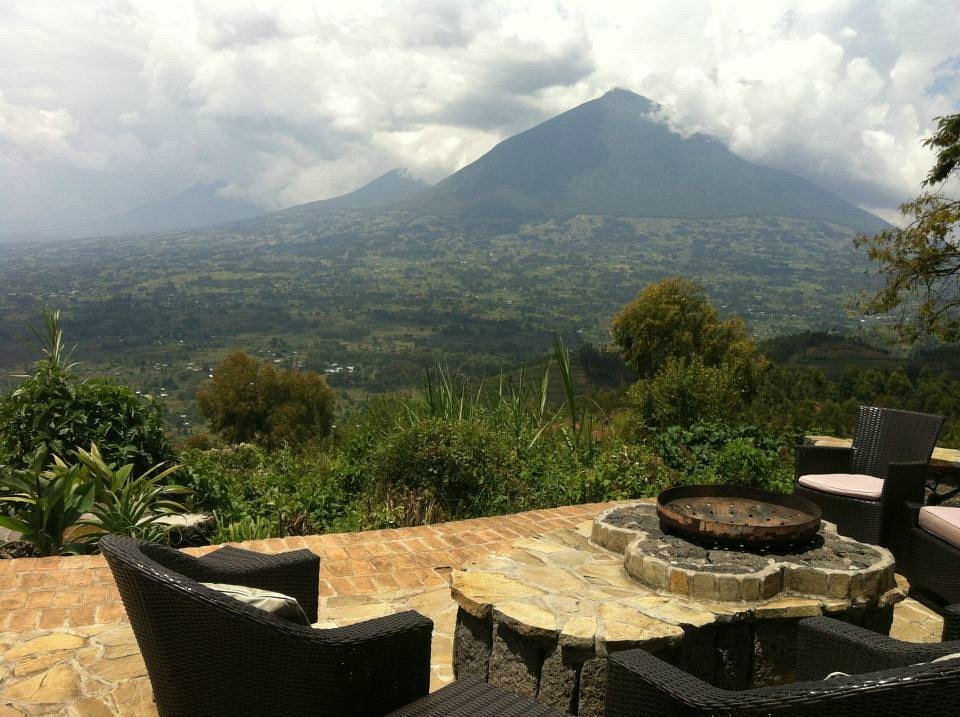
The village is located on the edge of Volcanoes NP and the local community displays the traditional ways of living, traditional dances and songs (Intore, Ikinimba, Batwa dances and many more), local fire making, visit to the kings house replica, Batwa shooting arrows, Traditional healer (with Kubandwa/Nyabingi experience), grinding millet on traditional stones, banana beer making experience and many more.
5 main gorilla groups habituated for tourism:
-
- The Susa group which has more than 38 individuals (toughest trek)
- The Amahoro group which has 14 individuals
- The Sabinyo group which has 11 individuals
- The Umubano group has 8 individuals (this break away group of Amahoro)
- Group 13 has 18 individuals
Other places of interest in Rwanda…
Nyungwe Forest National Park
Nyungwe forest is an Albertine Rift montane rainforest. The Albertine Rift forms the epicentre of Africa’s montane rainforest circle. It is dominated by a series of mountain chains, originating on the Lendu Plateau in northern Uganda and Congo, running south through the Rwenzori mountains, western Rwanda and Burundi, to some isolated massifs on the shores of Lake Tanganyika.
The Albertine Rift eco-region is one of Africa’s most endemic rich regions. Nyungwe forest has only recently been awarded the status of National Park and became the largest protected high-altitude rainforest in East Africa. It has been particularly important to protect the forest reserve as the highest population pressures in Africa are to be found within the Albertine Rift, and this forest hosts the biggest water reservoir for the country.
The highland forest covers 970 km² and has a unique habitat. The park has 25 % of the primates of Africa with its 13 recorded primate species including chimpanzees, golden monkeys, mangebeys, colobus and vervet monkeys and three species of bushbaby. The forest is also a haven for birds with over 300 recorded species including the Ruwenzori turaco, Ross’s turaco, Grey–cheeked hornbill, Red-throated alethe, Red-breasted sparrow hawk, White-headed wood-hoopoe, Kungwe apalis, Ruwenzori batis, Blue-headed and Regal sunbirds.
Nyungwe Forest has rich and wide species of flora with 200 species of trees and more than 100 species of orchid! The park has an extensive network of walking trails leading through various waterfalls and viewoints. Nyungwe offers scenic views over the forest, Lake Kivu and part of the Virungas.
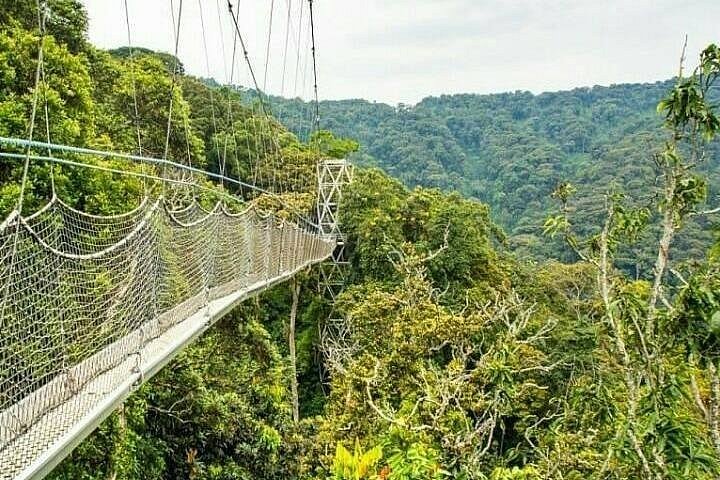
Akagera National Park
Is located in the east of Rwanda along the Akagera river which is the natural border with Tanzania. The park was created in 1936 and was once in terms of natural beauty, landscape, scenery and animal life, one of the best national parks. The National Park has been de-gazetted by two-thirds of its original territory due to human pressure.
Wildlife has also been considerably reduced during the war by heavy poaching. The park has still a remarkable selection of birdlife with over 500 bird species in its swamps and wetlands along the Akagera River.
Set at a relatively low altitude on the border with Tanzania, Akagera National Park could scarcely be more different in mood to the breezy cultivated hills that characterise much of Rwanda. Dominated scenically by the labyrinth of swamps and lakes that follow the meandering course of the Akagera River, the most remote source of the Nile, this is the archetypical African savannah landscape of tangled acacia woodland interspersed with open grassland.
In the 1960s, the Park was part of a much larger ecosystem that included Uganda’s Kikagati Game Reserve, Lake Mburo National Park, and rangeland areas north to the Katonga River (Uganda). Across the Akagera River to the east, the ecosystem extended into Tanzania’s Ibanda and Rumanyika Game Reserves, with corridors of relatively unsettled wood and bushland linking these areas to the Biharamulo and Burigi Game Reserves farther south, between Lake Victoria and the Rwanda border. Today, the Akagera-Lake Mburo ecosystem is fragmented and its wildlife populations are confined to small, disturbed enclaves.
Akagera NP and Lake Mburo NP, which are surrounded by cattle ranches, have been both reduced. Uganda’s Katonga WR is also isolated by surrounding villages, and its wildlife populations have been greatly reduced. On the Tanzania side, human settlements block wildlife corridors to Biharamulo and Burigi. Thus, the protection of Akagera is critically important for the conservation of the remnants of this unique and diverse biotic community. Camping alongside the picturesque lakes of Akagera is a truly mystical introduction to the wonders of the African bush.
Pods of 50 hippopotami grunt and splutter throughout the day, while outsized crocodiles soak up the sun with their vast jaws menacingly agape. Magically, the air is torn apart by the unforgettable high duetting of a pair of fish eagles, asserting their status as the avian monarchs of Africa’s waterways. Lining the lakes are some of the continent’s densest concentrations of waterbirds, while the connecting marshes are the haunt of the endangered and exquisite papyrus gonolek, and the bizarre but rare shoebill stork – the latter perhaps the most eagerly sought of all African birds.
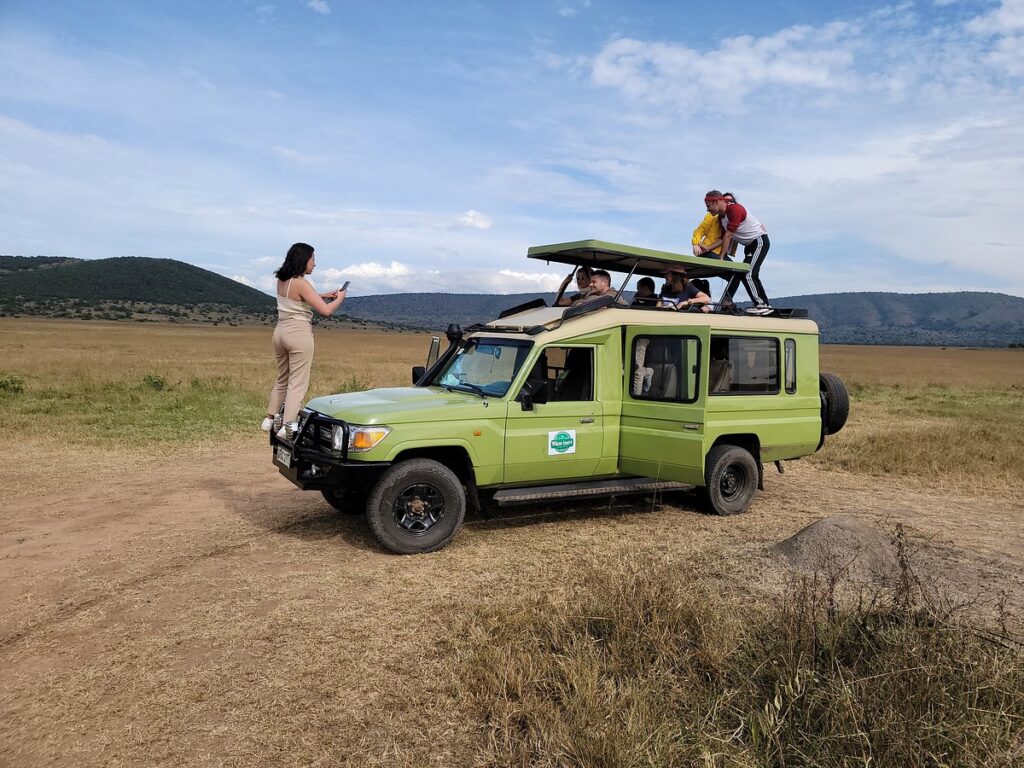
Volcanic Lakes
The five volcanic lakes; Kivu, Bulera, Ruhondo, Bunyonyi and Mutanda, on the borders of Rwanda and Uganda have their own special attractions. Lake Kivu, on the Rwanda/Congo border, is the largest of the volcanic lakes, more like a giant inland sea with some interesting towns bordering its banks.
Lake Kivu is often referred to as “the exploding lake” due to the trapped methane beneath the bedrock which is currently being tapped for use as fuel.
Kibuye, two hours from Kigali, is a relaxing retreat for swimming, canoeing and water-skiing. Gisenyi, once a famous resort in the country’s colonial past, now has a sleepy, forgotten air with some fine but neglected buildings from the Belgian era. The twin lakes of Burera and Ruhondo are attractive places to visit after gorilla tracking in PNV in Rwanda.
Popular Programs – Safari & Gorilla Trekking Ideas
Jolita Safari runs two types of safari in Rwanda:
- Scheduled safaris depart on set dates and follow a set itinerary. A minimum of two persons travel on each scheduled safari.
- Tailor-made, private safaris are created specifically to suit individual interests to meet where, when and what they want to do.
If you wish to have a short gorilla trek in Rwanda (minimum 3 days) as an extension to a Kenyan, Tanzanian or Ugandan Safari, then please contact us for details of any special offers and a program tailored to meet your requirements and interests.
